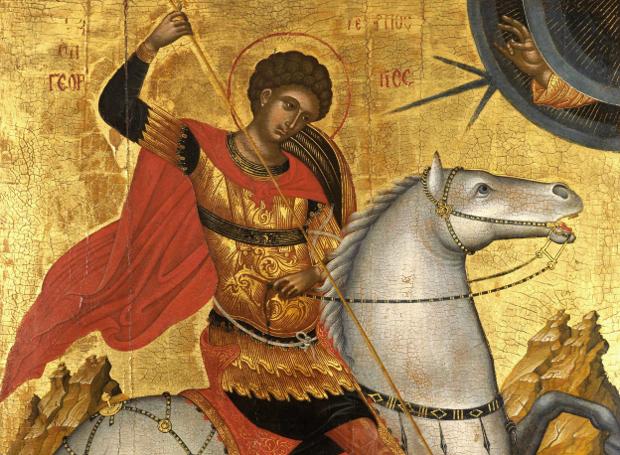After the cessation of the persecutions and the prevalence of Christianity throughout the Roman state, under Constantine the Great, the Christians erected a magnificent Church in Lydda of Joppa, where they transferred the holy relic of the Holy Great Martyr George to worship it now without fear.
After the deposition of the holy relic, the opening of the Church took place on November 3, and since then every year our Church, on this day, carries out the collection of the holy relics of the great martyr and the opening of his Church in Lydda.
Saint George was most likely born in the region of Armenia. His parents were Gerontius from Cappadocia and Polychronia from Palestine.
The Saint lived at the end of the 3rd century AD. and the beginning of the 4th century, during the time of Emperor Diocletian. According to tradition, at an early age, he moved with his mother to Lydda, due to his father's sleep.
Then Saint George joined the army, where he distinguished himself for his skills and bravery, which is why he gained the appreciation of Diocletian, who anointed him Duke, with the title of Count, in the Anikioron battalion of the imperial guard .
But when Diocletian wanted to impose, even by force, idolatry and the worship of the emperor as God, Saint George reacted by asking: "why should innocent blood be shed and the worship of the Emperor be imposed?"
And after saying these words, he confessed his faith in the God-man Jesus Christ, thus alienating all those present, who tried to convince him. Saint George, however, remained unwavering in his faith in Christ, which is why he was led to martyrdom, which he endured with the help of God's Grace.
Diocletian, therefore, ordered that he be thrown into prison and tortured. So they placed his feet in a wood and, moreover, placed a large stone on his chest until the next day, on which Diocletian proceeded to interrogate George.
Diocletian at first tried to tempt George. However, since he could not drag George to destruction, he ordered that the Saint be tied to a large wheel, which was filled with sharp irons, so that when it turned it would tear the holy body of George. Then, by divine intervention, George was freed and his wounds were healed.
As soon as they saw this sign, Protoleon, Anatolius, Protoleon, Victor, Acindynus, Zoticus, Zeno, Christopher, Severianus, Theonas, Caesarius, and Antony, and many others, professed their faith in Jesus Christ. This event enraged Diocletian even more, who ordered them to be killed.
Next, he ordered a pit to be filled with water and lime to throw George into, for three days and nights, so that his body would decompose. When the three days passed and they found Saint George standing in the lime praying, the people began to shout that "the God of George is great".
Diocletian, perceiving this sign of God's Grace as a magic trick, ordered that they put on George red-hot shoes, which had iron nails, and force him to walk.
However, because Grace continued to cover the Saint's body, Diocletian called a magician, who was called Athanasios, to subdue George. The magician brought two vessels which contained poison. By the power of the name of Jesus Christ, George drank both poisons without suffering the slightest. The event disarmed the sorcerer, who confessed his faith in the God of George. Then Diocletian ordered Athanasius to be killed as well.
Diocletian was so enraged that even for his own wife Alexandra, he issued an order to imprison her and the next day to behead her, since she too, like the previous ones, confessed her faith in Jesus Christ. Alexandra, while praying in prison, fell asleep before the executioners beheaded her.
Then, and while Saint George was sleeping, he saw in his dream Jesus Christ, who assured him that he would receive the crown of martyrdom and be worthy of the glory of God.
When he was then dragged before Diocletian, he suggested that he sacrifice to the idol of Apollo, but instead George, when he entered the temple with the sign of the Cross, threw the idol down. Then the persecuting Emperor ordered that George be beheaded. It was then Diacainissimus Friday, April 23, 303.
His holy body, together with that of his holy mother, who was martyred on the same, probably, day as him, was intercepted by Pasikrates, a faithful associate of George, who transported them to Lydda in Palestine.
From there, as sources testify, the holy relics of Agia Polychronia were transported to the West by the Crusaders.
The collection of the relics of Saint George is commemorated, as we noted above, on November 3.
